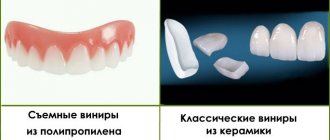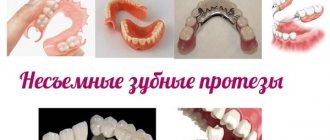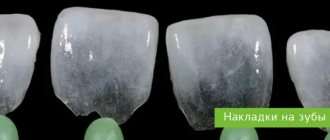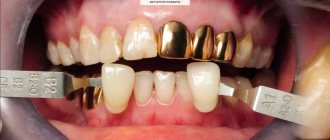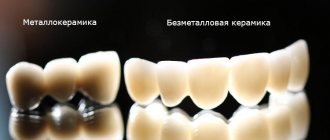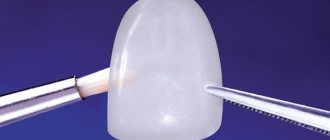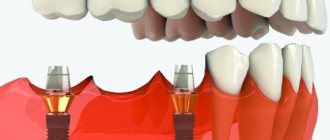Contraindications and restrictions
Since we objectively consider veneers, with their advantages and disadvantages, we note that they have an important practical disadvantage - they are not suitable for everyone.
Doctors do not recommend installing these microprostheses in the following cases:
- There are no premolars (“sixes”), so there are difficulties with chewing function.
- The bite is seriously deformed.
- The incisor is significantly damaged, and therefore it is difficult (there is nothing) to attach the plate.
- The volume of the filling exceeds 50% - this also reduces the reliability of fixation.
- The patient is interested in martial arts, contact sports, or other activities that can cause jaw injuries.
- A person has bad habits that contribute to the appearance of caries or other diseases, for example, bruxism or a passion for cracking nuts.
In any of these situations, you can use some other restoration option. Moreover, such plates must be worn with caution so as not to damage them.
Is it possible to carry out professional hygiene with veneers and lumineers?
Not only is it possible, but it is also necessary. When performing hygiene, be sure to remind the doctor that you have dental veneers installed in order to select a gentle ultrasonic treatment mode. Frequency – 1-2 times a year or as needed, depending on the quality of home care. But many patients, after installing veneers, carry out hygiene without effort, i.e. They treat renewed teeth with care, which causes plaque to accumulate faster. So you need to be prepared for the fact that you will have to undergo comprehensive cleaning even more often.
Air Flow technology is prohibited because abrasive particles are used - they can damage the smooth surface of the pads. Remember about home hygiene - this is the only way to maintain the health of your teeth and the condition of your microprostheses.
The benefits of veneers for teeth
Providing a beautiful smile and hiding minor defects, they have the following practical advantages:
- Durability - 5 years is their minimum service life, 7-10 is average (with careful biting of food, oral hygiene and compliance with other rules).
- Environmentally friendly, durable structures designed to minimize the risk of chipping.
- Hypoallergenic - in the manufacture of such pads, materials are used that not only do not cause irritation or other negative reactions, but are also biocompatible with all tissues of the body.
- Aesthetics – when considering the pros and cons of veneers for the front teeth, it is important to consider that they are completely invisible compared to other incisors; It’s not a problem to choose the shade, gloss and even the degree of transparency similar to natural enamel.
- Resistance to staining - the plates do not change their color after drinking tea, wine, coffee and other products, and do not turn yellow as a result of smoking or simply over time; If necessary, they can always be polished.
In addition, microprostheses are distinguished by gentle installation: before fixing them, there is no need to grind the incisor, it is enough to just remove a thin layer of enamel. Well, the edges of these overlays do not have to be hidden in the gums or other soft tissues of the oral cavity. This means no discomfort: with them, a person does not feel a foreign body at all and smiles as naturally as possible. There is also no need to get used to it.
What hygiene products should you have in your arsenal?
Hygiene products after installation of veneers and lumineers
| Name | Description |
| Toothbrush | Only with soft bristles - use it to clean the very surface of veneers and lumineers. Too hard hairs can lead to cracks. The teeth themselves can be brushed with a regular, medium-hard brush. Do not use electric brushes specifically for teeth with veneers - vibration can lead to the veneers coming off. Again, such brushes use quite aggressive bristles and even plastic elements that can damage the material and make it rougher - you should definitely avoid such attachments. |
| Toothpaste | Without the addition of abrasive particles (not bleaching!), such a paste can also lead to the formation of microcracks on the surface of the dentures. |
| Irrigator | Allows you to clean both the interdental spaces and the surface of the veneers from plaque. An additional bonus is a massage of the gums - the mucous membranes are saturated with oxygen, metabolic processes in them are restored. |
| Mouthwash | Choose the product that you need, taking into account your existing problems: to combat gum inflammation, to reduce tooth sensitivity, to strengthen enamel (with fluoride). |
What are the disadvantages of veneers that need to be taken into account?
The main disadvantage is that they cannot be removed by yourself or even dismantled without damaging them. These are not braces. Well, the enamel needs to be prepared - yes, in a thin layer, only 0.5-0.7 mm, but even such an impact can bring negative consequences. Protection against pathogens, aggressive environments, mechanical and chemical factors deteriorates.
As a result, you cannot simply remove the plates - after this you need to either attach new ones or use some other method of restoring the beauty of your smile.
Existing pathologies should also be taken into account. In severe cases, microprostheses can provoke a change in diction. Another disadvantage of veneers lies in the fact that the teeth protruding from under them will still be stained and darken, which means that over time they will become different in color, at least on the inside. To prevent this aesthetic problem, you need to change your menu and stop smoking. Although giving up bad habits is, in principle, a sound idea, even if everything is fine with a smile.
These overlays must be fixed by a specialist, because in case of non-compliance with the technology or errors, the following unpleasant consequences are possible:
- Loose fit and, as a result, darkening of the plate.
- Protruding edges that can cause injury to the soft tissues of the oral cavity.
- A manifestation of hypersensitivity, indicating either poor enamel cleaning or the development of caries.
In addition, you can break off a piece of such a microprosthesis if you thoughtlessly bite into too hard food.
Veneer replacement process
Let's say right away - it doesn't hurt. The entire procedure is performed under local anesthesia, so the patient may experience only mild discomfort. There are 2 ways to remove veneers from teeth.
The first method is classic. They are simply cut down with a diamond bur
. The main thing for the doctor is to stop in time and not damage the thinnest layer of enamel, which is useful for attaching new linings. But in this case it is necessary to completely remove not only the veneer, but also the cement.
The second way is innovative. Plates are removed using a laser beam
. The laser instantly heats the dental cement and it breaks down. This allows you to remove the veneers from your teeth in a matter of seconds.
Composite veneers applied directly cannot be removed with a laser, only with a bur.
Benefits and harms
It is important to understand that the pros and cons of veneers directly affect the quality of your bite. Thus, without much effort, you can visually correct minor imperfections and ensure a whiter and brighter smile. And this is without grinding down the incisor, only with the removal of a thin layer of enamel. If all the rules are followed, the plate will need to be replaced only after 10-20 years - the positive effect is obvious.
On the other hand, abandoning them after the first fixation is already problematic. You have to wear them for the rest of your life, periodically lightening them or putting on new ones. Why? Because 0.5-0.7 of the natural protective coating has already been removed. And the same premolars under microprostheses may ache, because after dental treatment they will become more sensitive and will react more sharply to hot and cold food.
So you should carefully weigh the pros and cons before deciding to have your smile corrected.
What you can and cannot eat after installation of veneers and lumineers
If you have veneers and lumineers, the most important thing is to limit the load on the front teeth. That is, give up anything solid—excessive pressure can cause the plates to crack or peel off.
- do not bite off any food, even the softest. You need to get used to cutting or separating foods into small pieces - this applies to vegetables, fruits, meat, crackers and even cookies. Chew only with lateral teeth without overlays,
- give up the seeds - at least peel them by hand and chew them with your side teeth,
- use fibrous foods with caution - they can get stuck in the interdental spaces - it will be quite difficult to remove them with dental floss,
- it is necessary to abandon “coloring” foods (beets, red wine, black tea, coffee) or minimize their consumption, since the risk of changing the shade of dentures, especially composite and ceramic ones, significantly increases,
- Sudden changes in temperature (first eating hot meat, then drinking it with cold milk) are prohibited, as are too hot or cold foods and drinks - this can lead to cracks in the material and resorption of the composite glue. Ultimately, the overlay will simply come off.
There is absolutely no difference between veneers and lumineers in terms of care. They are fixed equally well, but veneers may fit the gum a little less tightly - the thicker the plate, the more “step” remains between the veneer and the mucous membrane. It can chafe and cause inflammation. Therefore, it is the gums that need to be given the most attention after restoration.
Cost and service life
Veneering, as an artistic restoration procedure, is always an individual work, painstaking and precise, requiring time and skill, designed for a number of sessions, which affects costs.
Also, prices directly depend on factors such as:
- material and type of records;
- fastening technology;
- number of nozzles;
- associated problems and pathologies.
The average service life is from 5 years (for composite) to 7-8 (for ceramic) or even up to 20 (for zirconium). True, these are not guaranteed figures: the time of comfortable wearing highly depends on attentiveness and accuracy. Some people manage to chip together microprostheses within a week, having decided to chew a pistachio or a “Grilyazh” candy, while others use them happily ever after, following all the rules prescribed by the dentist.
The range in cost allows you to make a choice. You can settle on budget options made from filling materials, get used to them, and then change to better ones. Well, or immediately spend money on a structure made of zirconium and ceramics for the long term. It's up to you to decide, but remember that each new installation means grinding down the enamel and paying for the dentist's labor.
Can I use dental floss?
There are no clear prohibitions on the use of dental floss and interdental brushes, but you need to be extremely careful when using them. After prosthetics, microgaps between teeth are naturally preserved. But here it is very important not to move the thread from the gums to the edges (i.e., not to make vertical movements) - of course, not immediately, but gradually due to such actions the lining can be damaged. If you want to use floss, insert the tip not from below (from the cutting surface), but directly into the area between the teeth in the gum area - into the largest gap. After cleaning, remove it in the same way.
The same with brushes - when you remove them from the interdental space, be extremely careful. Choose the thinnest brushes. And best of all, buy an irrigator. This is an excellent replacement for both dental floss and brushes.
“Pay special attention to the condition of the gums, especially where the mucous membrane comes into contact with the edge of the veneer or lumineer. Due to tissue injury, inflammation may occur, which will lead to the fact that the pads will have to be removed for treatment, or due to a violation of aesthetics. For example, if gum recession begins and the roots of the teeth become exposed.”
Dzhutova Aida Vladimirovna Implant surgeon, periodontist Experience more than 10 years make an appointment
Do you dream of a beautiful smile? We have developed COMPLEXES of veneers for the smile area - place 4, 6 or 12 onlays at once! Save up to 30 thousand rubles and get a Hollywood smile!
sign up now
Indications for installation
Dentists usually suggest thinking about installing veneers to those patients for whom enamel whitening has proven ineffective, for example, with incomplete amelogenesis, fluorosis, so-called tetracycline teeth.
Moreover, sometimes these 2 procedures very often go hand in hand: first, the doctor lightens the enamel, waits at least 2 weeks for the natural shade of the teeth to be restored. Then the color of the veneers is selected and they are installed. This approach allows you to brighten your smile as much as possible.
In addition to lightening tooth enamel, indications for installing onlays are:
- traumatic chipping of a front tooth;
- unaesthetic gaps (trema and diastema) between teeth;
- pigmentation of the filling and pigment spots on the tooth tissue around the restorative structure;
- any non-carious defects of enamel and dentin;
- cracks on the tooth;
- exposure of the tooth root - gum recession.
For patients with a deep bite, veneers will be a good alternative to a crown, since in this case there is too little space on the oral surface of the teeth to install an oversized structure.
Discount on veneers up to 30%! Details from administrators
Moscow
Only a doctor can say for sure whether it is possible to correct a particular defect by installing veneers. You can always ask other questions about ceramic and composite onlays in our dental center. Professionals work here, who every day give their patients the opportunity to smile without embarrassment.
“Veneers dull the sense of taste”
The taste of food may change if the patient has composite veneers installed after incomplete polymerization. In this case, impurities are formed in the residual monomer of the dental veneers - hence the unpleasant sensations in the mouth and the changing taste of products.
How to avoid this? Install high-quality ceramic veneers.
What it is?
A veneer is an overlay with a maximum thickness of 0.5 mm, made of composite material or porcelain. The tooth hidden behind it looks perfect because it masks minor enamel defects.
Overlays first appeared in the 30s of the last century in America. They were invented by C. Pincus. In this way, the dentist helped Hollywood stars achieve the perfect smile. The tooth was covered with an adhesive compound, which attached the veneer for up to 2-3 days. At that time, no one thought about whether it would cause harm, since no preliminary grinding was required. Modern records are strikingly different from the first ones, but still allow you to achieve the desired aesthetic effect in a short time.
Is it possible to smoke if you have veneers?
Of course, you need to give up smoking. Firstly, for the general health of the body. Secondly, in order to preserve the color of the veneers. Of course, they will darken along with the enamel of living teeth, so there will be no obvious contrast. But unlike natural teeth, they cannot be whitened – the process is irreversible. Thirdly, when smoking, the gums suffer greatly - with veneers, the risk of mucosal recession increases, and when smoking it is even higher. Therefore, if possible, it is still better to give up this bad habit. Or at least strengthen hygiene and visit a doctor for comprehensive cleaning 2-3 times more often.
How do you know when it’s time to change veneers?
Monitor the condition of the veneers, the quality of their fixation on the teeth, pay attention to microcracks, gaps and roughness - even in a small gap between the veneer and the enamel, bacteria will accumulate, which will lead to the destruction of living tooth tissue. Do not forget that in order to maintain the warranty on the product, you need to visit the dentist every six months - he will be able to assess the condition of the veneers and the teeth under them. He will also clarify that it is time to update the prostheses. However, this may be required after at least a couple of years if you do not take care of hygiene, and at least after 10 years (depending on the material) if you take care of your new teeth.
Choosing between veneers and lumineers? Only original Cerinate and DUO lumineers. No fakes, 100% quality guarantee.
sign up now
Can veneers and lumineers be whitened?
No, veneers, lumineers and any filling materials (composites) cannot be whitened. The chemical properties of the gel allow it to penetrate only between the tissue cells of natural teeth. During cleaning and polishing, you can only remove plaque - then teeth with dentures will really become whiter. Therefore, it is so important to maintain hygiene and carry out daily cleaning on time.
As you can see, lifestyle and hygiene when having veneers on your teeth are quite simple, and, in fact, are not much different from the rules for caring for your own teeth. Remember: how long veneers or lumineers will last depends not only on the quality of the work done by your doctor, but also on you.
In what cases is it permissible to place veneers on teeth that already have fillings?
The very fact of having fillings rarely becomes the reason why a dentist dissuades a patient from veneers. On the contrary, one of the cases when a person is offered veneers is if the fillings are located on the front side of the teeth and differ from natural tooth enamel in shade and texture. This becomes a quick and effective solution to an aesthetic problem.
In addition, veneers tend to protect teeth from various external influences - and along with them, fillings are also protected. A properly installed and high-quality filling under a veneer will last significantly longer - at least as long as the veneer itself will last (and the service life of ceramic veneers, for example, before they are replaced is about 10 years).
And there are even cases when the veneer itself is essentially a filling. We are talking about composite veneers. Veneers made of reflective composite material are not so durable, however, if there is a slight carious lesion on the surface of the enamel (that has not penetrated into the tooth, into the dentin), then it can be removed and not put a regular filling, but a composite veneer can be made.
“Veneers are installed in one day”
Restoration using veneers requires at least two visits to the dentist.
At the first appointment, the doctor examines the dental cavity, determines whether this restoration method is suitable for the patient, and makes impressions of the teeth.
At the second appointment, veneers are installed.
In some cases, three appointments are required because at the second appointment, the doctor grinds down the teeth and temporarily places plastic veneers.



